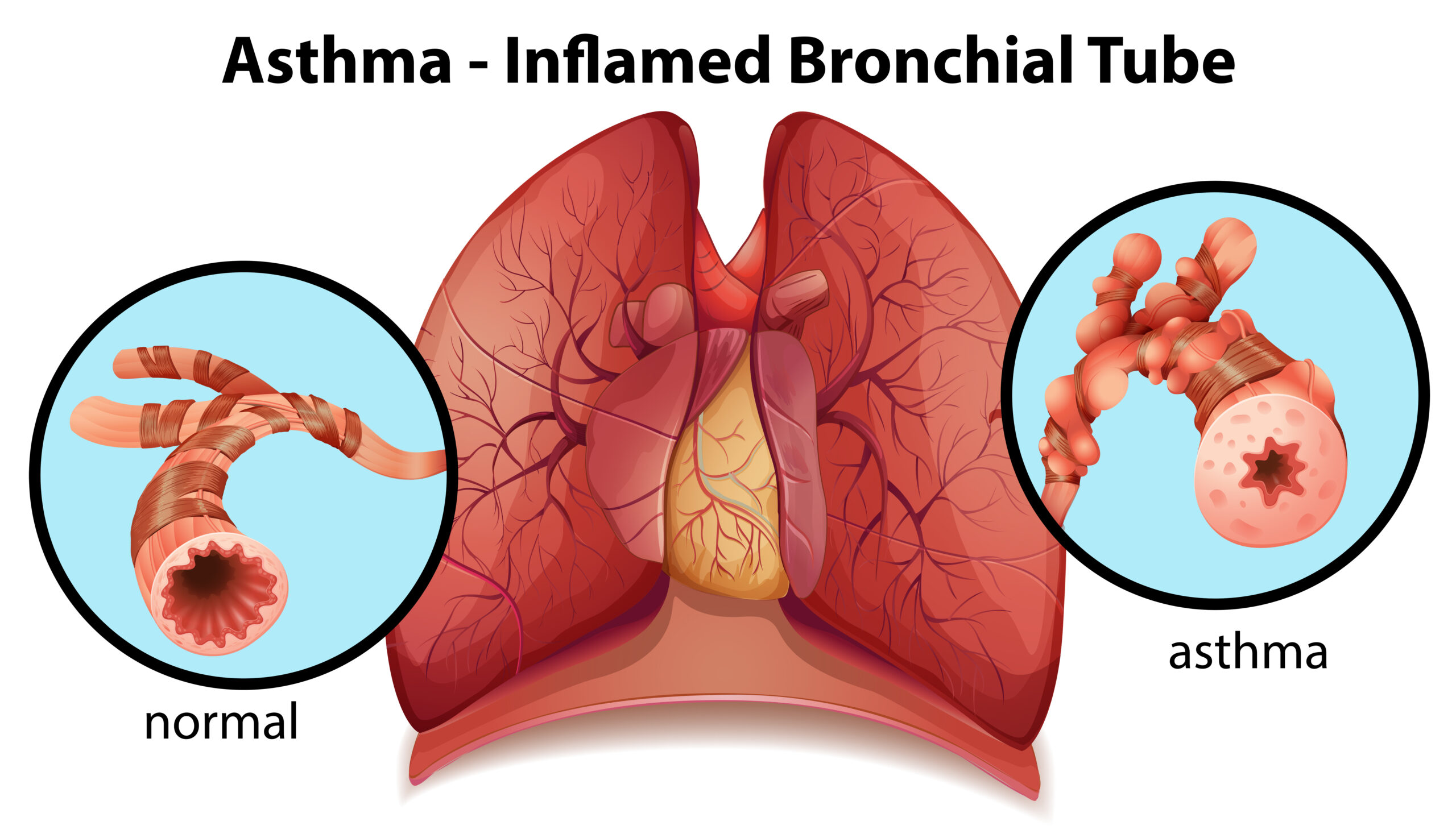Introduction
Welcome to a comprehensive exploration of asthma, a prevalent respiratory condition affecting people worldwide. From its underlying mechanisms to effective management strategies, we’ll journey through the world of asthma. Let’s embark on this informative adventure to gain insights into living well with this condition.

Table of Contents
What is Asthma
Asthma is a chronic respiratory ailment characterized by the inflammation and narrowing of the airways, which makes breathing difficult. This condition varies in severity, ranging from occasional mild discomfort to more frequent and intense symptoms. Asth_ma episodes, often referred to as asthma attacks, can be triggered by diverse factors such as allergens, respiratory infections, exercise, and even emotional stress.
Types of Asthma
Understanding the different types of asthma is key to tailoring effective management plans:
- Allergic Asthma
Allergic asth_ma, the most common type, stems from exposure to allergens like pollen, dust mites, mold, or pet dander. When the immune system reacts to these triggers, it leads to inflammation in the airways, resulting in the classic symptoms of it. - Non-Allergic Asthma
Non-allergic asth_ma, on the other hand, is triggered by irritants like cold air, smoke, strong odors, or respiratory infections. In this case, the immune system’s response is not linked to allergies. - Exercise-Induced Bronchoconstriction (EIB)
Engaging in physical activities can lead to exercise-induced bronchoconstriction, where the airways narrow during or after exercise. This type of asth_ma requires special attention to ensure a balance between staying active and managing it.

Symptoms and Diagnosis
Recognizing asthma symptoms and obtaining a timely diagnosis are pivotal steps toward effective management:
- Shortness of Breath: A sensation of breathlessness, especially during physical activities or at rest.
- Wheezing: A high-pitched whistling sound when breathing, caused by narrowed airways.
- Chest Tightness: Discomfort or pressure in the chest area due to restricted airflow.
- Coughing often becomes more pronounced, especially during the late hours of the night or in the early hours of the morning.
Diagnosing asth_ma involves a combination of factors, including medical history, physical examinations, and lung function tests like spirometry.

Mastering Asthma Management
Successfully managing asthma involves a multifaceted approach that empowers individuals to control their condition and lead fulfilling lives:
- Medication Management: Inhalers and oral medications, such as bronchodilators and anti-inflammatory drugs, play a crucial role in symptom control and prevention of exacerbations.
- Trigger Avoidance: Identifying and minimizing exposure to triggers, whether allergens or irritants, can significantly reduce the frequency and intensity of asth_ma episodes.
- Creating an Asthma Action Plan: Collaborating with a healthcare provider to create a personalized action plan helps individuals recognize early signs of worsening symptoms and know when to adjust their medication or seek medical assistance.
- Regular Check-ups: Periodic visits to a healthcare professional ensure that the asth_ma management plan remains up-to-date and effective.
Nurturing a Healthy Life with Asth_ma
Asthma need not impede one’s ability to lead a vibrant life. With mindful practices and proper care, individuals with asth_ma can thrive: - Staying Physically Active: Regular exercise is essential for overall health. However, people with asth_ma should work closely with their healthcare providers to develop an exercise plan that minimizes the risk of triggering symptoms.
- Balanced Diet: A diet rich in fruits, vegetables, lean proteins, and whole grains supports lung health and overall well-being.
- Stress Management: Stress can exacerbate asth_ma symptoms. Incorporating stress-reduction techniques like deep breathing, meditation, or yoga can be beneficial.
Navigating Childhood Asth_ma
For parents of children with asthma, extra vigilance and education are crucial: - Monitor Symptoms: Children may not always communicate discomfort. Watch for signs of wheezing, shortness of breath, coughing, or chest tightness, especially during play or exercise.
- School Support: Inform teachers and school staff about your child’s condition, medications, and emergency action plan.
- Educational Tools: Provide age-appropriate asth_ma education to help your child understand their condition and take an active role in their self-care.
Looking Ahead: Advances in Asthma Treatment
Research advancements are continuously shaping the landscape of asth_ma treatment:
In conclusion, asth_ma is a manageable condition that, with the right knowledge and strategies, need not hinder one’s quality of life. By identifying triggers, adhering to treatment plans, and adopting a health-conscious lifestyle, individuals with asth_ma can enjoy full and active lives.

Frequently Asked Questions (FAQs)
- Can asth_ma develop later in life?
A. Absolutely. Adult-onset asth_ma can manifest due to various factors such as occupational exposures, infections, or hormonal changes. - Is asth_ma genetic?
A. While there’s a genetic component, asth_ma’s development also involves environmental factors. - Can asth_ma symptoms change over time?
A. Yes, asth_ma symptoms can vary in frequency and intensity throughout a person’s life. - Is there a link between allergies and asth_ma?
A. Yes, allergies and asthma are interconnected. Allergic reactions can trigger asth_ma symptoms. - Can pets worsen asth_ma symptoms?
A. Yes, pet dander can be an asth_ma trigger. Proper cleaning and minimizing exposure can help manage symptoms.

